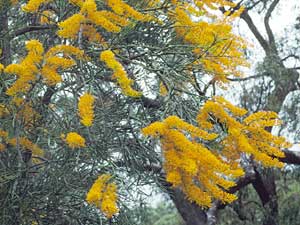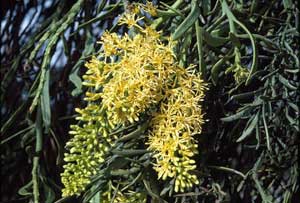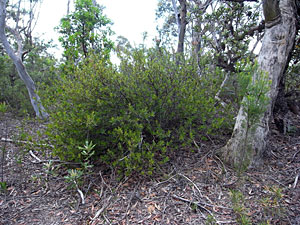Mistletoes - evolution
 |
 Nuytsia floribunda |
Tree mistletoes in Loranthaceae
The most celebrated terrestrial loranth is the Western Australian Christmas Tree, Nuytsia floribunda, which occurs on the sand plains of the southwest. It can exceed 10 m in height, and its roots spread for tens of metres, making haustorial root connections with any host it contacts, including herbs and grasses. It has been found guilty of damaging underground telephone cables with its girdling haustoria. The crown of the tree is a mass of golden-orange flowers in summer (right). Its fruits are dry and strongly 3-winged, probably as an aid in dispersal, but the seeds do retain a thin sticky layer like all their relatives.
Another terrestrial loranth is the shrubby Atkinsonia ligustrina, an endangered species known from a few localities in the Blue Mountains of New South Wales. Its small, open, perfumed flowers are insect-pollinated, and the drupe-like fruit has a thin sticky layer on the seed. Photos: flowers ![]() , fruit
, fruit ![]() , shrub
, shrub ![]() .
.
The third terrestrial loranth is the South American tree mistletoe, Gaiadendron punctatum, which ranges from Chile to Central America. Its seeds apparently germinate in the crown of a host tree, and its epicortical roots grow to the ground like those of a strangling fig. It is reported not to form haustorial attachments to the host stems, but only to epiphytes lodged in the tree crown, and may become free-standing following death of the supporting tree.
These tree mistletoes share many primitive characters (12-chromosome genome, pollination syndrome, embryology, floral and inflorescence structure), and are basal to the loranth evolutionary tree.
Several other mistletoe species, normally aerial parasites on tree branches, have occasionally been reported as growing in the ground. These cases are difficult to confirm, and seem unlikely, given the special adaptations in mistletoes for aerial growth. Possibly they represent cases of mistletoes growing close to the base of the host tree, perhaps with epicortical runners reaching down to ground level.
Amongst others, claims of terrestrial growth have been made for Amylotheca dictyophleba and Amyema scandens in New Caledonia, and for Helixanthera ligustrina in the southeast Asian region.
![An Australian Government Initiative [logo]](/images/austgovt_brown_90px.gif)



